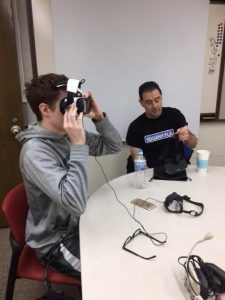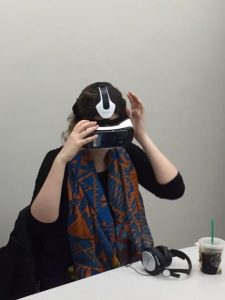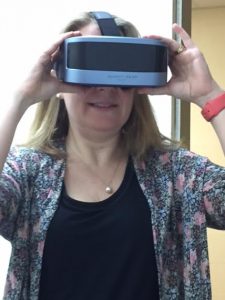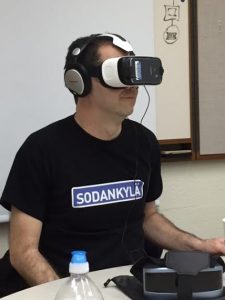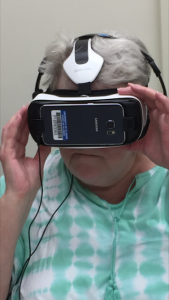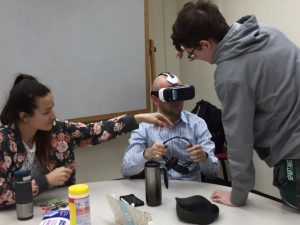Past Projects
Language Learning through Immersion via Virtual Reality
Principal investigators: Steve LaValle, Silvina Montrul, and Robb Lindgren
Language learning through immersion with new cost-effective virtual reality technology can potentially facilitate personalized learning anytime and anywhere. The team led by Prof. Steve LaValle (Computer Science), Silvina Montrul (Spanish and Portuguese and Linguistics) and Prof. Robb Lindgren (Curriculum and Instruction) is working with graduate students Anna Tsiola (Linguistics), Begoña Arechabaleta (Spanish and Portuguese) and Cameron Merrill (Computer Science) and Nancy Wesselman from St. Lois, MO Public school district to develop immersive language learning activities in Spanish as a second language to be adapted to K-12 and college. In the photos of the group meeting below, we are evaluating the first iteration of our virtual panorama of La Plaza Mayor in Madrid.
Articles and genericity in native and non-native Brazilian Portuguese
Principal investigator: Tania Ionin
Co-investigators: Silvina Montrul; Hélade Santos; Elaine Grolla, University of São Paulo
Investigation of articles and genericity in the Brazilian Portuguese of native speakers as well as of learners who speak English and/or Spanish as their prior languages. Focus on the acquisition of semantic contrasts between different types of generics, and on the role of transfer in third language acquisition.
Bilingual past
Silvina Montrul (PI), Sara Mason, Darren Tanner
Comparison of heritage speakers and L2 learners in acquisition and processing of several grammatical properties.
Differential Object Marking in Spanish and Hindi monolinguals and bilinguals
processing
Silvina Montrul (PI), Rakesh Bhatt, Archna Bhatia (co-PI), Darren Tanner
Study of linguistic knowledge and processing in heritage speakers, second language learners, children and adults.
Early and late bilingual processing of Spanish wh- dependencies with case marking
Principal investigator: Jill Jegerski
Graduate research assistant: Krista Evensen
This is a visual world eye-tracking study that examines the auditory processing of wh- questions among heritage bilinguals and second language learners of Spanish.
Epistemic and scopal properties of Russian indefinites
Principal investigators: Tania Ionin and Luisa Martí (Queen Mary University of London)
Graduate research assistant: Tatiana Luchkina
This project uses experimental methodology to examine the properties of different types of Russian some indefinites. The focus is on the behavior of indefinites in different types of scope configurations as well as on their epistemic properties.
Explicit and implicit knowledge in the second language acquisition of English definites by speakers of Korean
Principal investigator: Tania Ionin
Co-investigator: Myeong Hyeon Kim
Undergraduate research assistants: Jiwoong Hong (Spring 2014), Katharine Tyndall (Fall 2014)
This project compares accuracy in L1-Korean L2-English learners’ use of the English definite article in tasks targeting more explicit vs. more implicit knowledge. The study also examines whether the semantics of Korean demonstratives influences patterns of L2-English article use, at explicit and/or implicit levels.
Gender and number in L2 Swahili word recognition
Principal investigator: Spinner, P.
Co-investigators: Foote, R., & Upor, R.
While previous research indicates that native speakers and early learners of gender-marking languages use gender-marked elements of noun phrases during the spoken word recognition process, it seems that late L2 learners do not do the same. The goal of this study is to determine whether native speakers and late L2 learners of Swahili make use of gender and number marking on verbs to facilitate noun recognition.
Incipient second language acquisition in children ages 4-9
Silvina Montrul (PI), Tania Ionin, Melissa Bowles, Alexandra Morales, Rejane Dias, Andrei Cimpian
Study of comprehension of gender agreement in noun phrases, plural agreement in nouns and verbs, articles and genericity and the copulas ser and estar in children learning Spanish as a second language. Comparison with incipient adult L2 learners.
Morphological decomposition in L1 and L2 Swahili
Principal investigator: Foote, R.
Co-investigators: Spinner, P., & Upor, R.
The goal of this project is to determine whether native speakers and L2 learners of Swahili decompose nouns into their roots and inflectional affixes. Swahili differs from languages in which morphological decomposition has been studied previously, in that rather than using suffixes to mark gender and number, Swahili uses prefixes.
Quantifier scope in native and non-native Russian
Principal investigator: Tania Ionin
Graduate research assistant and co-investigator: Tatiana Luchkina
Undergraduate research assistants: Helen Sdvizhkov (University of Chicago, Summer 2014), Jessica Langer (Fall 2014)
This project investigates the availability of surface scope vs. inverse scope to double-quantifier sentences such as One girl stroked every kitten in Russian. The relative contributions of word order, prosody, and information structure are examined. The project furthermore compares scope preferences among native speakers, second language learners, and heritage speakers of Russian.
Reactivity in L2 writing: Effects of thinking aloud on complexity, accuracy, and fluency
Principal investigator: Melissa Bowles
Collaborator: Florencia Henshaw
This study seeks to gain insight into L2 and heritage learners’ writing process and resulting written product using think-alouds. In a within-subjects design, all participants write two narratives in their second or heritage language (in both cases, Spanish), one silently and the other while thinking aloud. The results will shed light on how similar or different the two groups are in terms of processing and will also determine whether the think-aloud method caused any significant differences between the texts in terms of complexity, fluency, or accuracy.
The processing and production of agreement morphology in native, heritage, and L2 Arabic
Principal investigator: Foote, R.
Co-investigator: Saadah, E.
The goal of this project is to compare the processing and production of person, number, and gender morphology across native speakers, heritage speakers, and second language learners of Arabic. Existing research on other languages indicates that while native speakers process and produce agreement morphology with high levels of accuracy and automaticity, heritage speakers and second language learners tend to do so less efficiently and with lower levels of accuracy. We will investigate whether these three groups of Arabic speakers differ in how they comprehend or produce agreement morphology, either quantitatively or qualitatively, and whether this varies based on the type of agreement or the type of agreement morphology. We will also examine whether overall proficiency level plays a role in any differences found.
The role of explicit information in L2 and HL instruction
Principal investigator: Melissa Bowles
Collaborator: Florencia Henshaw
Despite its frequency in the classroom, the role of explicit information in L2 and heritage language acquisition is still hotly debated. In this study, L2 and heritage learners’ response times and accuracy are measured while they go through one of two types of instruction, one containing explicit information (Processing Instruction) and the other identical but lacking such explicit information (Structured Input). Groups are compared in terms of response time and accuracy during the treatment as well as pre-posttest gains in accuracy on the target structure.
Weaker links? Grammatical gender in L2 noun production
Principal investigator: Foote, R.
A number of studies examining grammatical gender in L2 acquisition indicate that learners are less sensitive or insensitive to gender when processing their second language. In addition, they are consistently less accurate in the production of gender agreement than native speakers. One hypothesis regarding why this may be the case proposes that links between lexical items and gender nodes are weaker in L2 learners than in native speakers of gender-marking languages. The goal of this study is to investigate whether this is true, and whether morphophonological transparency plays a role in the strength of the links that are formed.
A Comparative Syntactic Description of 5 Arabic Dialects
Principal investigator: Elabbas Benmamoun
RAs: Mahmoud Abunasser, Rania Al-Sabbagh, Dana Shalash
This project aims to provide a detailed parallel syntactic description of five Arabic varieties, representing the main geographical regions of the Arab world from the Atlantic ocean in Africa to the Gulf in Asia. It will collect data on a large number of syntactic constructions and patterns in a numner of varieties and analyze them. The study will also aim to engage important issues in theoretical and comparative syntax that arise in the context of studying closely related language varieties.Funded by the National Science Foundation (2009-13).
Arabic Morphology in Heritage Speakers and L2 Learners
Principal investigator: Elabbas Benmamoun
Collaborators: Silvina Montrul, Abdulkafi Albirini, Emman Saddah
Investigation of productive patterns of plural morphology in Jordanian and Egyptian Arabic speakers and in L2 learners of Arabic.
Articles and Genericity in L2 Acquisition
Principal investigator: Tania Ionin, co-principal investigator: Silvina Montrul
Collaborators: Mónica Crivos, Universidad CAECE Mar del Plata, Argentina; Ji-Hye Kim, SungKyunKwan University; Vadim Philippov, Orel State University
Comparative study of the second language acquisition of articles and genericity by Spanish-speaking, Korean-speaking, and Russian-speaking learners of English, and by English-speaking learners of Spanish. Focus on the acquisition of semantic contrasts between singular and plural generics, and between indefinite and definite generics; investigation of the relative roles of language transfer, and access to semantic universals.
Bilingual Past Project (stage 2)
Principal investigator: Silvina Montrul
Collaborator: Rebecca Foote
RAs: Justin Davidson, Israel de la Fuente, Celester Larkin
Systematic comparison of different aspects of Spanish morphology, syntax and semantics in adult heritage speakers and proficiency-matched L2 learners of Spanish.
Classroom Spanish Learner-Learner Interactions: L2 Learners and Heritage Language Learners
Principal investigator: Melissa Bowles
RA: Florencia Henshaw
The benefits of having foreign language learners interact with native speakers have been clearly shown through research. But most foreign language learners come into contact with other non-native speakers (e.g., classmates). This study investigates the extent to which there are linguistic benefits for non-native speaker pairs interacting in a foreign language. Simultaneously, it investigates whether there are differences depending on whether the non-native speakers are heritage language learners or second language learners. This project investigates interactions between pairs of L2 learners, pairs of heritage language learners, and mixed pairs.
Comparative Heritage Languages
Principal investigator: Silvina Montrul, co-principal investigators: Rakesh Bhatt and Roxana Girju
RA: Kirsten Hope and Archna Bhatia
Comparative study of differential object marking, dative case and clitics in Spanish, Hindi and Romanian heritage speakers and fully fluent native speakers. Funded by the National Science Foundation (2009-13).
Grammatical Constraints on Second Language Sentence Processing
Doctoral Dissertation Funded by the National Science Foundation (2010-12)
PhD student : Eunah Kim, advisor: Silvina Montrul, committee members: James Yoon and Kiel Christianson
Incipient second language acquisition in 4-9 year old children learning Spanish
Principal Investigator: Silvina Montrul
Collaborators: Tania Ionin, Melissa Bowles, Alexandra Morales, Rejane Dias, Laura Romaní
The main objective of this project is empirical: to begin to document the initial state of L2 acquisition and the nature of transfer from the L1 in 4 to 9 year-old children whose L1 is English. The project will follow 40 children for an entire academic year (about 9 months) learning Spanish in a school setting. We will investigate the development of vocabulary, pronunciation, morphology (articles, copulas, gender and plural agreement, possessive prepositional phrases), syntax and semantics. We ask whether L1 transfer is stronger in phonology and syntax (adjective noun order) than in morphology (gender and number) and semantics (interpretation of articles), as predicted by the Domain-by-Age-Model.
Inflectional Frames in L2 Word Production
Principal investigator: Rebecca Foote
Study examining the formation of inflectional frames during L2 word production by learners of Spanish at different proficiency levels.
Interpretation of nominals in L2 English
Principal investigator: Tania Ionin, co-principal investigators: Soondo Baek, Eunah Kim
Collaborators: Heejeong Ko (Seoul National University), Ken Wexler (MIT)
Task comparison of how English noun phrases are produced are interpreted by Korean-speaking learners of English. Extension to noun phrase interpretation in native Korean.
Perception of articles in L2 English
Principal investigator: Tania Ionin, Co-principal investigator: Lisa Pierce
Investigation of the role of perception in the L2 acquisition of English articles by Korean-speaking and Mandarin-speaking learners of English. Comparison between perception, production and comprehension of English articles.
Processing of English Relative Clauses by Adult L2 Learners of Different Working Memory Capacity
Doctoral Dissertation Funded by the National Science Foundation (2010-12)
PhD student: Soondo Baek, advisor: Tania Ionin
Reformulation in Second Language Writing
Principal investigator: Melissa Bowles
Collaborator: Rebecca Adams, University of Auckland
This project investigates the role of corrective feedback in the writing of second and heritage language learners.
Testing explicit and implicit language knowledge
Principal investigator: Melissa Bowles
A major focus of research in language acquisition research is determining the nature of language knowledge. This project develops and pilot-tests a series of tests of language knowledge with both L2 and heritage learners.
The Acquisition of Exempt Anaphors in English as a Second Language
Principal investigator: James Yoon
Collaborator: Silvina Montrul
RA: Eunah Kim
Study of binding interpretation with picture NPs by Korean learners of English using eye-tracking.
The Development of Lexical Knowledge in L2 Arabic
Principal investigator: Rebecca Foote
Investigation of the development of lexical knowledge and organization in L1 English learners of L2 Arabic.
The Expression of Genericity in English, Spanish and Brazilian Portuguese
Principal investigator: Tania Ionin
Collaborators: Silvina Montrul, Hélade Santos
Cross-linguistic experimental comparison of how different types of generics are interpreted in English, Spanish and Brazilian Portuguese. Extension to third language acquisition of Brazilian Portuguese by speakers of English and Spanish, with focus on whether transfer takes place from both the first and the second languages.
The Role of Instruction in Heritage Language (Re)acquisition
Principal investigator: Melissa Bowles
Collaborator: Silvina Montrul (see project # 1)
Study of the role of negative evidence in the instructed acquisition of differential object marking (a-personal) in L2 learners of Spanish and Spanish heritage language learners.
The role of modality in Grammaticality Judgment Tasks
Principal Investigator: Silvina Montrul
This research investigates a methodological variable that may affect the results of aural GJTs and their potential usefulness with populations who may be less comfortable with the visual modality, like school-age children and heritage speakers. In particular, we investigate the role of native vs. foreign accent in stimulus presentation.
The scope of English indefinites
Principal investigator: Tania Ionin.
An experimental semantics study of how different types of indefinites are interpreted by native English speakers, with a possible extension to L2-acquisition of English. Focus on the ability of indefinites to escape scope islands; investigation of the factors (including determiner form, stress pattern, and island type) that affect the availability of long-distance scope.
